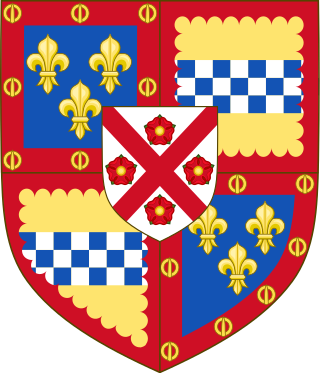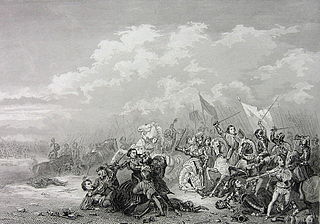Contents
| |||||
| Decades: | |||||
|---|---|---|---|---|---|
| See also: | Other events of 1503 History of France • Timeline • Years | ||||
Events from the year 1503 in France
| |||||
| Decades: | |||||
|---|---|---|---|---|---|
| See also: | Other events of 1503 History of France • Timeline • Years | ||||
Events from the year 1503 in France

The 1490s decade ran from January 1, 1490, to December 31, 1499.

Year 1503 (MDIII) was a common year starting on Sunday of the Julian calendar.

1622 (MDCXXII) was a common year starting on Saturday of the Gregorian calendar and a common year starting on Tuesday of the Julian calendar, the 1622nd year of the Common Era (CE) and Anno Domini (AD) designations, the 622nd year of the 2nd millennium, the 22nd year of the 17th century, and the 3rd year of the 1620s decade. As of the start of 1622, the Gregorian calendar was 10 days ahead of the Julian calendar, which remained in localized use until 1923.

The 1500s ran from January 1, 1500, to December 31, 1509.
Year 1495 (MCDXCV) was a common year starting on Thursday of the Julian calendar.

1645 (MDCXLV) was a common year starting on Sunday of the Gregorian calendar and a common year starting on Wednesday of the Julian calendar, the 1645th year of the Common Era (CE) and Anno Domini (AD) designations, the 645th year of the 2nd millennium, the 45th year of the 17th century, and the 6th year of the 1640s decade. As of the start of 1645, the Gregorian calendar was 10 days ahead of the Julian calendar, which remained in localized use until 1923.

Gonzalo Fernández de Córdoba was a Spanish general and statesman. He led military campaigns during the Conquest of Granada and the Italian Wars, after which he served as Viceroy of Naples. For his extensive political and military success, he was made Duke of Santángelo (1497), Terranova (1502), Andría, Montalto and Sessa (1507), and earned the nickname El Gran Capitán.

Barletta is a city and comune in Apulia, in southeastern Italy. Barletta is the capoluogo, together with Andria and Trani, of the Province of Barletta-Andria-Trani. It has a population of around 94,700 citizens.

The Battle of Cerignola was fought on 28 April 1503 between Spanish and French armies outside the town of Cerignola, Apulia, Kingdom of Naples, approximately 80 kilometres (50 mi) west of Bari. The Spanish force under the command of Gonzalo Fernández de Córdoba comprising around 9,000 men, including 2,000 Landsknecht pikemen, 1,000 arquebusiers and 20 cannons, defeated the French force of 9,000 men, mainly gendarme heavy cavalry and Swiss mercenary pikemen, with about 40 cannons, led by Louis d'Armagnac, Duke of Nemours, who was killed during the battle.

Pedro Navarro, Count of Oliveto was a Navarrese military engineer and general who participated in the War of the League of Cambrai. At the Battle of Ravenna in 1512 he commanded the Spanish and Papal infantry, but was captured by the French. In the service of Francis I of France, he would supervise the French crossing of the Alps before the Battle of Novara in 1513.

The Italian Wars of 1499–1504 are divided into two connected, but distinct phases: the Second Italian War (1499–1501), sometimes known as Louis XII's Italian War, and the Third Italian War (1502–1504) or War over Naples. The first phase was fought for control of the Duchy of Milan by an alliance of Louis XII of France and the Republic of Venice against Ludovico Sforza, the second between Louis and Ferdinand II of Aragon for possession of the Kingdom of Naples.

Cerignola is a town and comune of Apulia, Italy, in the province of Foggia, 40 kilometres southeast from the town of Foggia. It has the third-largest land area of any comune in Italy, at 593.71 square kilometres (229.23 sq mi), after Rome and Ravenna and it has the largest land area of any comune in Italy among those that are not the provincial capital. In 2017, it had a population of 58,534.

Louis d'Armagnac, Duke of Nemours, was a French nobleman, politician and military commander who served as Viceroy of Naples from 1501-1503, during the Third Italian War. He was known for most of his life as the Count of Guise, and inherited the Duchy of Nemours following his brother Jean's death in 1500.

Bernard Stewart, 3rd Seigneur d'Aubigny was a French soldier, commander of the Garde Écossaise, and diplomat belonging to the Scottish family of Stewart of Darnley.

The Battle of Seminara, part of the First Italian War, was fought in Calabria on 28 June 1495 between a French garrison in recently conquered Southern Italy and the allied forces of Spain and Naples which were attempting to reconquer these territories. Against the redoubtable combination of gendarmes and Swiss mercenary pikemen in the French force, the allies had only Neapolitan troops of indifferent quality and a small corps of lightly-armed Spanish soldiers, accustomed to fighting the Moors of Spain. The result was a rout, and much of the fighting centered on delaying actions to permit the fleeing allied force to escape.

The Battle of Ruvo was fought on 23 February 1503 between a Spanish army under Gonzalo Fernández de Córdoba and a French army commanded by Jacques de la Palice. The battle was part of the Second Italian War and was fought at the city of Ruvo in the Province of Bari, modern-day Italy. The result was a Spanish victory.

Prospero Colonna (1452–1523), sometimes referred to as Prosper Colonna, was an Italian condottiero who was active during the Italian wars and served France, Spain, the Holy Roman Empire and various Italian states.
The Battle of Seminara of 1503 was fought on 21 April 1503 between Seminara and Gioia Tauro, Calabria, between French troops under the command of Bérault Stuart d'Aubigny and a Spanish force commanded by Fernando de Andrade during the Third Italian War.
Events from the year 1566 in France.
Events from the year 1500 in France